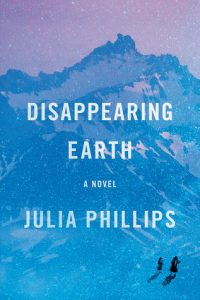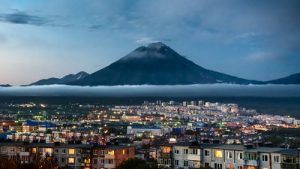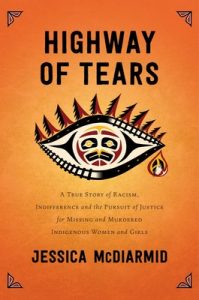 I’ll confess that before reading Disappearing Earth, I hadn’t heard about the indigenous Even people of Russia, nor of Kamchatka (my knowledge of history and geography, let alone the two combined, is woeful at best), but I can say that Phillips’ beautiful rendering of the landscape of Petropavlovsk-Kamchatsky and descriptions of the women living in the town (or the wide vicinity of it) in the novel made me want to find out more. (In fact, one of the characters in Disappearing Earth, the mother of the disappeared girls, also notes how she is unfortunately more ignorant than she’d like regarding the history of the treatment of indigenous peoples in Russia because it wasn’t in the curriculum when she was in school; she notes how her daughters would’ve known more, because they’re taught in school now about the indigenous peoples of northern Russia: what is taught, I’m not sure.) Disappearing Earth begins with the kidnapping of two girls – Alyona and Sophia, aged 11 and 8 – while they were walking around by themselves along the beach in late summer. But it doesn’t follow the same path other novels that start with a kidnapping might: the format itself is a twist on the thriller/investigative mystery genre, the portrayal of the useless and often misguided police officers only incidental to the much larger story told through different women in the area affected in various ways, large and small, by the kidnapping. This centering of women explores the ways in which women, especially indigenous women in Petropavlovsk-Kamchatsky, lack power in their lives; and immediately brings to mind the epidemic of missing and murdered indigenous women in North America (see Highway of Tears by Jessica McDiarmid, for which other resources I’ve also listed in a previous post). Which, interestingly enough, Phillips herself admits in an interview with The Paris Review:
I’ll confess that before reading Disappearing Earth, I hadn’t heard about the indigenous Even people of Russia, nor of Kamchatka (my knowledge of history and geography, let alone the two combined, is woeful at best), but I can say that Phillips’ beautiful rendering of the landscape of Petropavlovsk-Kamchatsky and descriptions of the women living in the town (or the wide vicinity of it) in the novel made me want to find out more. (In fact, one of the characters in Disappearing Earth, the mother of the disappeared girls, also notes how she is unfortunately more ignorant than she’d like regarding the history of the treatment of indigenous peoples in Russia because it wasn’t in the curriculum when she was in school; she notes how her daughters would’ve known more, because they’re taught in school now about the indigenous peoples of northern Russia: what is taught, I’m not sure.) Disappearing Earth begins with the kidnapping of two girls – Alyona and Sophia, aged 11 and 8 – while they were walking around by themselves along the beach in late summer. But it doesn’t follow the same path other novels that start with a kidnapping might: the format itself is a twist on the thriller/investigative mystery genre, the portrayal of the useless and often misguided police officers only incidental to the much larger story told through different women in the area affected in various ways, large and small, by the kidnapping. This centering of women explores the ways in which women, especially indigenous women in Petropavlovsk-Kamchatsky, lack power in their lives; and immediately brings to mind the epidemic of missing and murdered indigenous women in North America (see Highway of Tears by Jessica McDiarmid, for which other resources I’ve also listed in a previous post). Which, interestingly enough, Phillips herself admits in an interview with The Paris Review:
I don’t think of myself as engaging with the Russian literary tradition at all, really. I feel like what I brought to the story and the place were very much American concerns and American ideas. As much I tried to accurately reflect what I was seeing, what I was seeing was deeply informed, if not completely informed, by my Americanness.
(Julia Phillips in interview for The Paris Review: The Ideal Place to Disappear)
So then… why this isolated Russian Far East peninsula of Kamchatka?

Photo “Dusk over Kamchatka” by kuhnmi under Creative Commons license (https://www.flickr.com/photos/31176607@N05/24293043653. Accessed Feb 6, 2020)
Why set this kidnapping in the Russian peninsula of Kamchatka, this particular sparsely populated landscape? If Phillips realized she was not “engaging with the Russian literary tradition at all… [bringing] very much American concerns and American ideas”, why not somewhere in America out in the middle of somewhere similarly sparsely populated, somewhere where news also spreads slowly, information being lost or changed as it spread, as it did here in Disappearing Earth? Sarah Moss sums it up very well in her review of Disappearing Earth in The Guardian (forgive this huge quote: the last paragraph of Moss’s review, because she does sum this up really well): “But there’s no essential contradiction between exoticism and good writing, and in my view this novel is both: there’s no space for cultural difference here, no intuition that the lived experiences of women in Kamchatka might require a different vocabulary from those of North America, that readers of a novel set there might reasonably hope to glimpse a different reality. There’s always a conflict, of course, between “othering” and appropriation, between believing that differences of culture, history and language render groups of people incomprehensible to each other and insisting that the whole world is made in the image of one’s own assumptions. No individual book will resolve that contradiction, but one set so firmly at the centre of the dilemma needs at least to recognise the problem” (emphasis mine; Disappearing Earth by Julia Phillips review from The Guardian). While Moss appears to believe that Phillips herself is unaware of the dilemma, going by Phillips’ interviews, I’d actually say that she does recognize it. And I’m hesitant to write off the novel without doing further digging (though willing enough to raise the question here).
 I have to agree with Moss in acknowledging what appears to me right now as a somewhat unavoidable topic, because there were many times as I kept reading later on in the novel that I wondered whether it was that the experiences of the indigenous Even people in Russia so closely mirror that of indigenous peoples of North America, or at least what I know of that experience & the issues faced by indigenous communities in Canada (again, see Highway of Tears by Jessica McDiarmid, for which other resources I’ve also listed in a previous post), or whether it was because of the imposition of North American issues over this landscape that the similarities are there. Part of why I want to learn more about the history of Russia and its indigenous communities is because I want to know how much of this portrayal is culturally accurate, and how much is only an American overlay over top of the exoticized backdrop of Kamchatka?
I have to agree with Moss in acknowledging what appears to me right now as a somewhat unavoidable topic, because there were many times as I kept reading later on in the novel that I wondered whether it was that the experiences of the indigenous Even people in Russia so closely mirror that of indigenous peoples of North America, or at least what I know of that experience & the issues faced by indigenous communities in Canada (again, see Highway of Tears by Jessica McDiarmid, for which other resources I’ve also listed in a previous post), or whether it was because of the imposition of North American issues over this landscape that the similarities are there. Part of why I want to learn more about the history of Russia and its indigenous communities is because I want to know how much of this portrayal is culturally accurate, and how much is only an American overlay over top of the exoticized backdrop of Kamchatka?
What makes this entire process of realizing that this “othering” is happening slightly difficult is because Phillips is an amazing writer. Her writing transported me to the landscape of Kamchatka through the women’s narratives; threw in just the right amount of disorienting changes in perspectives (whenever the chapters changed to someone completely different) to make me want to keep reading and find out how all the characters were related, if at all, apart from through their knowledge of the missing girls; turned the idea of a kidnapping novel on its head and centered women’s stories. Throughout the entirety of Disappearing Earth, Phillips touched upon misogyny and racism (and racial prejudice), balancing those heavy topics with the beautifully illustrated and sparsely populated setting of Kamchatka that presented itself as the perfect locked-room mystery setting, as Phillips notes in an interview in The Paris Review. As I made my way through each of the different women’s lives, I couldn’t help but think that no one was “winning”, so to speak. Even if they were surviving and making their way through day to day, there is no individual glory here in each of these women’s lives, no victory over the misogyny, the racism, the bigotry. It’s clear Phillips did her research, spending her Fulbright scholarship on the Kamchatka Peninsula, a month “traveling across Russia’s easternmost tundra with the organizers of the Beringia, a 685-mile dogsled race” (The Paris Review), even writing a piece for BuzzFeed about the future of these Russian nomadic reindeer herders, highlighting the changes and issues the Even population face: Russia’s Nomadic Reindeer Herders Face the Future. But, as Moss notes, there’s no incompatibility between being an amazing writer who does their research, and exoticism.
I suppose the question really becomes, as with cultural appropriation: who is benefiting from this writing? (And, because it can’t be reduced so simply: is anyone being harmed by it, directly or indirectly?)
As a sidenote: though the title is wack, Is This the Right Way For Fashion to Do Cultural Appropriation opinion piece from Huffington Post. (No, because in this case permission was expressly given and the designer worked with the community, so I’d argue it’s not cultural appropriation in this case so much as cultural exchange, which yes, should probably be what we’re aiming for instead.)